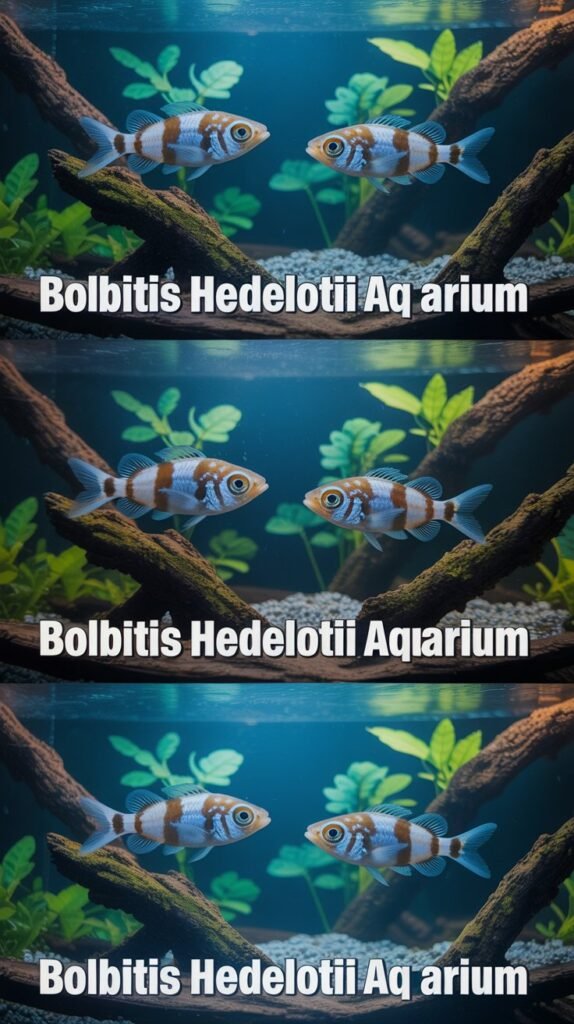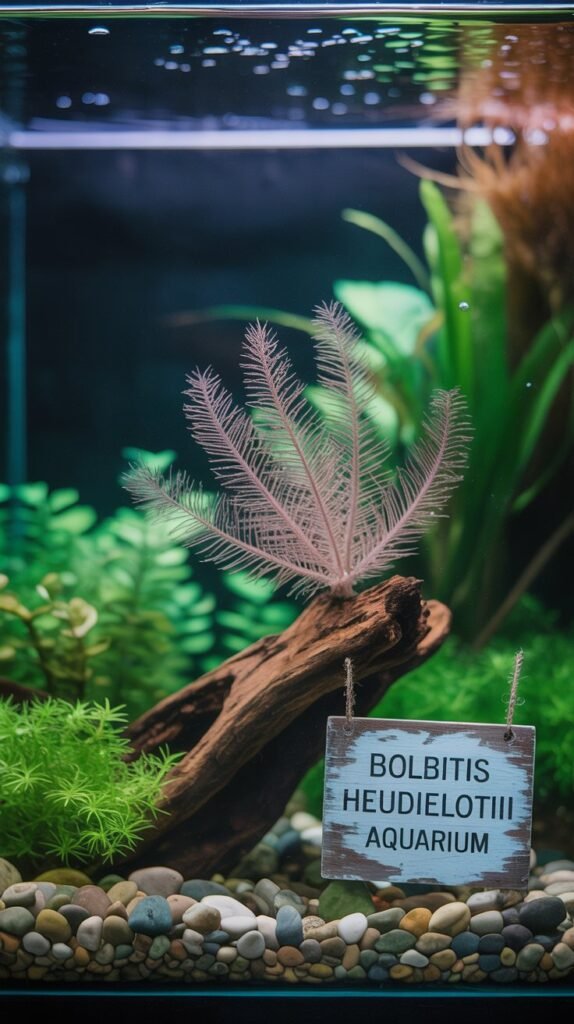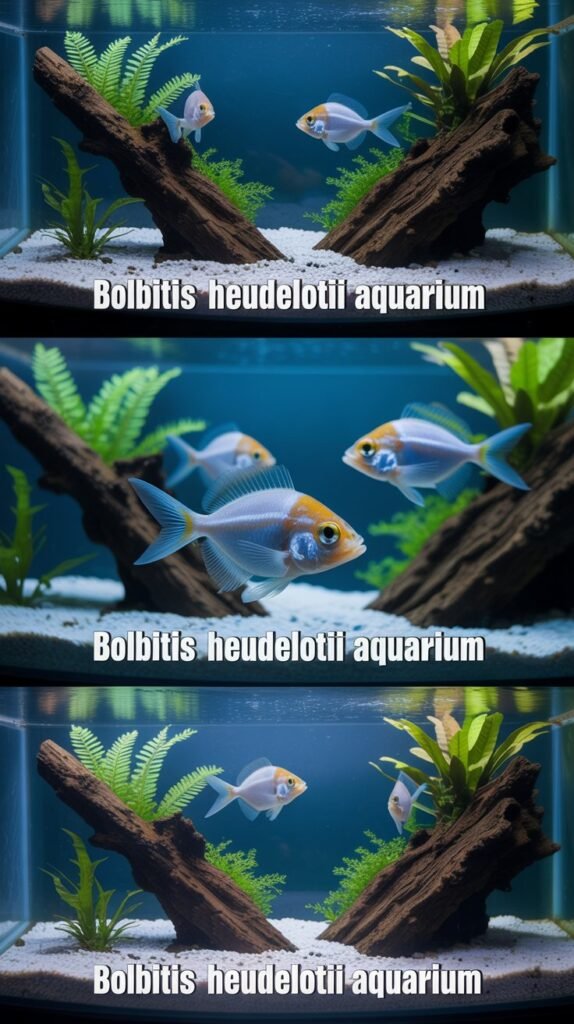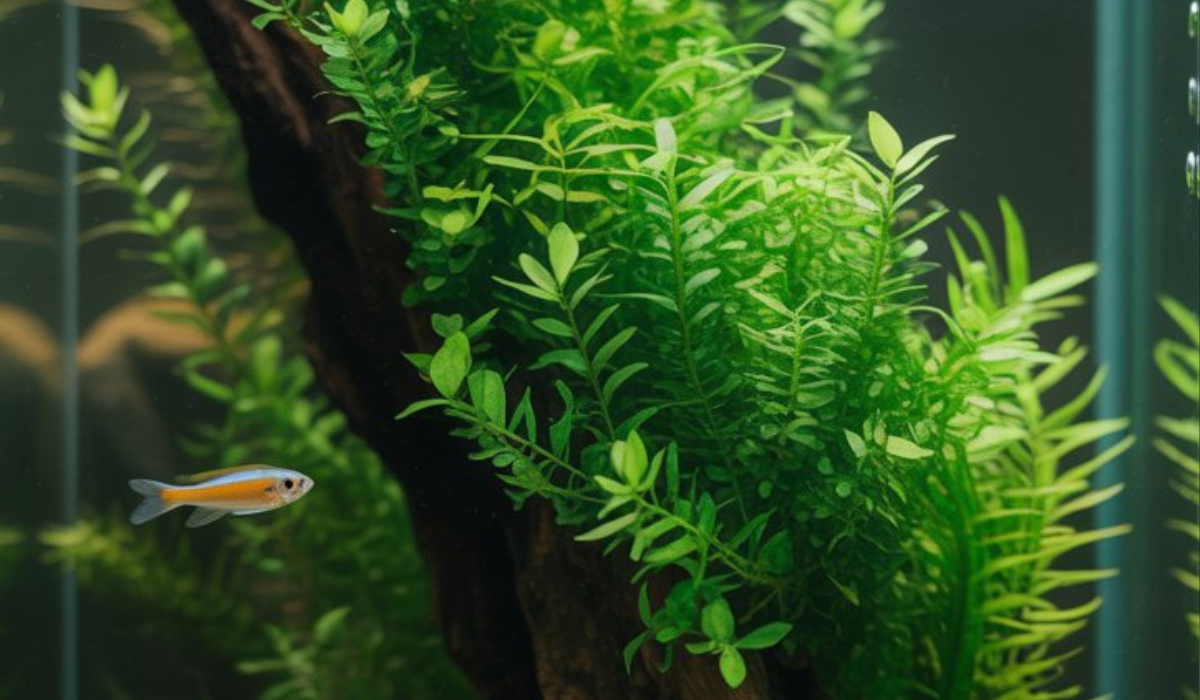When it comes to creating a lush, natural-looking aquascape, few plants are as elegant and captivating as Bolbitis heudelotii, also known as the African Water Fern. With its delicate green fronds and graceful growth pattern, this aquatic plant brings a sense of tranquility and depth to any aquarium setup. Whether you’re an aquascaping enthusiast or a beginner aquarium keeper, Bolbitis heudelotii offers the perfect blend of beauty and resilience.
In this comprehensive guide, we’ll explore everything you need to know about Bolbitis heudelotii aquarium care — including planting methods, lighting needs, water parameters, propagation, tank mates, and much more.
What Is Bolbitis Heudelotii?
Bolbitis heudelotii is a semi-aquatic fern native to tropical regions of West and Central Africa, particularly along the banks of the Congo River. It naturally grows attached to driftwood, rocks, and submerged surfaces, where it thrives in gentle water flow and shaded environments.
Also known as the African Water Fern, it belongs to the family Polypodiaceae, which includes many terrestrial and aquatic ferns. Its lush, translucent green leaves and slow growth make it a prized choice for aquascaping enthusiasts seeking a natural, jungle-like aesthetic.

Key Characteristics of Bolbitis Heudelotii
| Characteristic | Details |
|---|---|
| Common Name | African Water Fern |
| Scientific Name | Bolbitis heudelotii |
| Origin | Africa (Congo Basin) |
| Type | Rhizomatous Fern |
| Growth Rate | Slow to Moderate |
| Placement | Midground or Background |
| Lighting | Low to Medium |
| CO₂ Requirement | Optional but beneficial |
| Temperature Range | 20–28°C (68–82°F) |
| pH Level | 6.0–7.5 |
| Hardness | Soft to Moderately Hard |
| Propagation | Rhizome Division |
This plant’s slow-growing nature means it requires patience, but the end result is a breathtaking aquascape centerpiece.
Why Choose Bolbitis Heudelotii for Your Aquarium
There are many reasons why Bolbitis heudelotii has become a favorite among aquarists and aquascapers worldwide. Let’s look at what makes this plant so special:
1. Elegant and Natural Look
The finely divided, feathery leaves of Bolbitis add a unique texture to any aquarium. It pairs beautifully with driftwood, stones, and darker backgrounds.
2. Great for Shaded or Low-Light Tanks
Unlike many aquatic plants that demand bright light, Bolbitis heudelotii thrives in shaded or moderate-light environments, making it perfect for low-light aquascapes.
3. Algae-Resistant
Because of its slow growth and preference for shaded areas, it tends to develop less algae compared to fast-growing plants that compete for light and nutrients.
4. Low Maintenance
Bolbitis heudelotii is hardy once established. It doesn’t require constant trimming or fertilization, which makes it ideal for both beginners and busy aquarists.
5. Compatible with Many Fish and Shrimp
Its sturdy leaves provide a great hiding place for shrimp and fry. Moreover, most fish species don’t nibble on it, keeping it safe from damage.
Ideal Aquarium Conditions for Bolbitis Heudelotii
To bring out the best in your Bolbitis heudelotii, you’ll need to replicate its natural habitat conditions as closely as possible.
1. Water Parameters
- Temperature: 20–28°C (68–82°F)
- pH: 6.0–7.5
- Hardness: Soft to moderately hard water
- Flow: Moderate flow preferred
Bolbitis thrives in slightly acidic, clean, and oxygen-rich water. Using a canister filter or sponge filter can help maintain water quality and create gentle water movement.
2. Lighting
Bolbitis heudelotii prefers low to moderate lighting. Direct bright light can cause the leaves to develop algae or turn brown. Use LED lights with adjustable brightness and keep them on for about 6–8 hours daily.
3. CO₂ and Fertilization
While CO₂ supplementation is not mandatory, it significantly enhances growth and leaf color. If you want lush, healthy fronds, consider using a nano CO₂ system in your aquarium.
Fertilization should be minimal — a few drops of liquid fertilizers containing micronutrients like iron and potassium once a week will do.
4. Substrate
Bolbitis heudelotii does not require planting in substrate. In fact, burying its rhizome in the substrate can cause it to rot. Instead, it should be attached to rocks, driftwood, or ornaments using:
- Fishing line
- Cotton thread
- Aquarium glue
Over time, its rhizomes will anchor themselves naturally.
How to Plant Bolbitis Heudelotii in Your Aquarium

Proper planting ensures healthy growth and longevity. Follow these steps to successfully add Bolbitis to your aquarium:
Step 1: Prepare the Plant
Rinse the plant gently under lukewarm water to remove any debris, pests, or unwanted hitchhikers.
Step 2: Divide the Rhizome (Optional)
If your Bolbitis has a large rhizome, you can divide it into smaller sections. Each section should have a few leaves and healthy roots.
Step 3: Attach to a Surface
Use cotton thread, fishing line, or glue to attach the rhizome to a piece of driftwood, lava rock, or stone. Be careful not to cover the rhizome — only the roots should touch the surface.
Step 4: Position in the Tank
Place it in a low to medium-light area of the tank, preferably in a spot with gentle water flow. Avoid placing it too close to strong filters or direct light.
Step 5: Allow Time to Establish
Bolbitis grows slowly, so it might take a few weeks before new roots firmly attach and new fronds appear. Once established, it becomes very hardy.
Placement Ideas in Aquascaping
Bolbitis heudelotii’s versatility allows it to fit into multiple aquascaping styles:
- Midground Plant: Perfect for adding depth between foreground carpet plants and tall background stems.
- Background Plant: Works beautifully in smaller aquariums, where it can serve as a soft, green backdrop.
- Attached to Hardscape: Create a natural forest or riverbank look by attaching Bolbitis to driftwood or rock structures.
Pair it with plants like Anubias, Java Fern, Bucephalandra, or Cryptocoryne for a harmonious, low-maintenance aquascape.
Growth Rate and Maintenance
Bolbitis heudelotii grows slowly compared to many aquarium plants, typically producing 1–2 new fronds per month under ideal conditions. This slow growth means:
- Less trimming and maintenance.
- Lower nutrient consumption.
- Longer-lasting aquascapes without constant re-scaping.
When trimming is needed, cut older or damaged fronds close to the rhizome. Avoid cutting the rhizome itself.
Propagation of Bolbitis Heudelotii
Propagation is simple and rewarding. Follow these steps:
- Remove the Plant from the Tank: Gently detach it from its surface.
- Locate the Rhizome: The thick, horizontal stem is the rhizome — the source of new growth.
- Divide the Rhizome: Using sharp scissors or a clean blade, cut the rhizome into smaller sections (each with at least 2–3 leaves).
- Reattach the Sections: Tie each new piece to driftwood or stone using thread or glue.
- Reintroduce to Tank: Place them back into areas with good water flow and low light.
Over time, each rhizome section will develop roots and grow into a new plant.
Common Problems and Solutions

Even though Bolbitis heudelotii is a hardy plant, it can face a few challenges. Here’s how to troubleshoot common issues:
1. Melting Leaves
- Cause: Sudden water changes, poor acclimation, or CO₂ fluctuation.
- Solution: Maintain stable conditions and prune melted leaves. The plant usually recovers.
2. Algae on Leaves
- Cause: Excess light or nutrients.
- Solution: Reduce lighting duration, control feeding, and consider adding Amano shrimp or Nerite snails for algae control.
3. Rhizome Rot
- Cause: Burying the rhizome in substrate or stagnant water.
- Solution: Ensure the rhizome is exposed and attached to a hard surface.
4. Slow or Stunted Growth
- Cause: Insufficient nutrients or CO₂.
- Solution: Add liquid fertilizers and maintain consistent CO₂ levels if using injection.
Compatible Tank Mates for Bolbitis Heudelotii
Bolbitis heudelotii fits perfectly in community tanks, shrimp tanks, and planted aquascapes. Suitable tank mates include:
Peaceful Fish:
- Neon Tetras
- Rasboras
- Guppies
- Corydoras Catfish
- Dwarf Gouramis
- Endlers
Invertebrates:
- Amano Shrimp
- Cherry Shrimp
- Nerite Snails
- Mystery Snails
Avoid large herbivorous or aggressive fish like goldfish, oscars, or cichlids, as they may uproot or damage the fern.
Benefits of Having Bolbitis Heudelotii in an Aquarium
1. Improves Water Quality
Bolbitis absorbs ammonia, nitrates, and waste products, helping to maintain a balanced ecosystem.
2. Provides Shelter
Its dense leaves offer shelter for small fish, shrimp, and fry, making it ideal for breeding tanks.
3. Enhances Oxygen Levels
Like all aquatic plants, Bolbitis contributes to oxygenation through photosynthesis.
4. Aesthetic Value
Its natural, fern-like texture enhances aquascapes by providing a wild, forest-like ambiance.
5. Reduces Stress for Fish
The shaded areas created by Bolbitis make fish feel secure, reducing aggression and stress.
Tips for Thriving Bolbitis Heudelotii
- Maintain consistent temperature and pH levels.
- Avoid direct exposure to strong lighting.
- Perform regular water changes (20–30% weekly) to maintain clarity.
- Provide gentle water movement for oxygenation.
- Use liquid fertilizers sparingly to avoid algae.
With patience and care, Bolbitis heudelotii can live for years, becoming a focal point of your aquarium.
Bolbitis Heudelotii vs. Other Ferns
| Feature | Bolbitis Heudelotii | Java Fern (Microsorum pteropus) |
|---|---|---|
| Leaf Shape | Feathery, delicate | Broad, flat |
| Growth Rate | Slow | Moderate |
| Light Requirement | Low–Medium | Low–Medium |
| CO₂ Need | Optional but helpful | Not necessary |
| Ideal Use | Natural forest-style aquascapes | Beginner tanks |
| Rarity | Less common | Very common |
While Java Fern is more common, Bolbitis offers a more refined, elegant look that appeals to advanced aquascapers.
Where to Buy Bolbitis Heudelotii
You can find Bolbitis heudelotii at:
- Local aquarium stores
- Online aquascaping retailers
- Aquatic plant hobbyist groups
- Specialized aquarium plant farms
When purchasing, ensure you’re getting true Bolbitis heudelotii and not similar-looking ferns like Bolbitis heteroclita.
Conclusion
Bolbitis heudelotii, the African Water Fern, is a timeless addition to any aquarium setup. Its lush green foliage, low-maintenance care, and graceful flow in water make it a top choice for aquascapers and plant lovers alike. Whether you attach it to driftwood for a forest vibe or use it as a midground accent, it elevates the beauty of your underwater world.
For anyone looking to create a natural, serene, and long-lasting aquascape — Bolbitis heudelotii is the perfect choice.
Frequently Asked Questions (FAQs)
1. Is Bolbitis heudelotii a beginner-friendly plant?
Yes. It’s hardy and adaptable, making it great for both beginners and experienced aquarists.
2. Can Bolbitis heudelotii grow without CO₂ injection?
Yes, it can grow without CO₂, but adding CO₂ will result in faster growth and healthier fronds.
3. How do I attach Bolbitis to driftwood or rocks?
Use cotton thread, fishing line, or aquarium glue to tie the rhizome to hard surfaces.
4. Why are my Bolbitis leaves turning brown?
This usually happens due to excessive light, nutrient deficiency, or unstable water parameters.
5. Can Bolbitis grow emersed (above water)?
Yes. It can grow emersed in humid environments, such as paludariums or ripariums.
6. How often should I fertilize Bolbitis?
Once a week with liquid fertilizers containing micronutrients is sufficient.
7. How big does Bolbitis heudelotii grow?
In aquariums, it can reach up to 12–16 inches (30–40 cm) under optimal conditions.
8. Can Bolbitis grow in sand substrate?
It should not be planted directly in sand. Instead, attach it to rocks or wood to prevent rhizome rot.
9. Does Bolbitis need pruning?
Occasionally. Trim older or damaged leaves to promote new growth.
10. Is Bolbitis safe for shrimp tanks?
Yes! It’s 100% shrimp-safe and even provides great shelter for shrimp colonies

